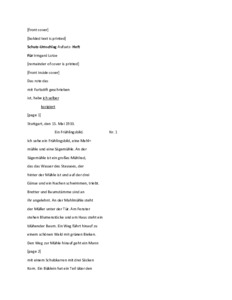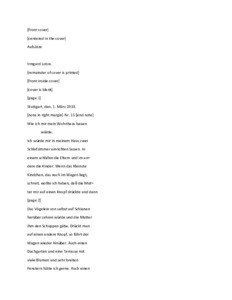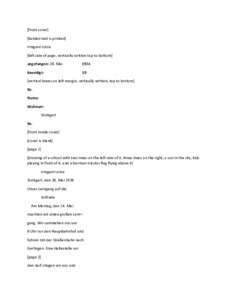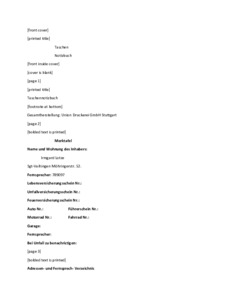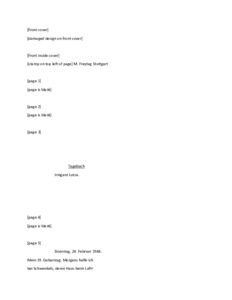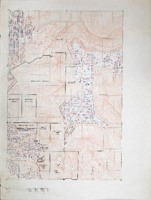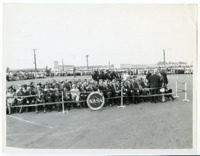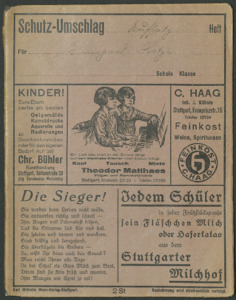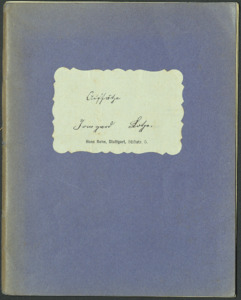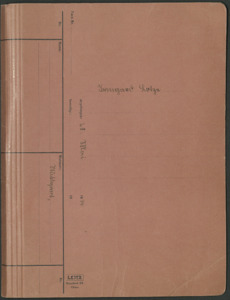
Browse Items (18 total)
Sort by:
-
Transcript of Irmgard Stuhlinger School Essays, No. 1 to No. 13
Irmgard Stuhlinger was the wife of Ernst Stuhlinger, a scientist acquired in Operation Paperclip. In these school essays, she discusses her daily life in Stuttgart, Germany, as a child. When writing these essays she was 8 years old. Some of the topics include a letter to family members, Christmas, descriptions of the weather, and talking about field trips. -
Transcript of Irmgard Stuhlinger School Essays, from No. 15
Irmgard Stuhlinger was the wife of Ernst Stuhlinger, a scientist acquired in Operation Paperclip. In these school essays, she discusses her daily life in Stuttgart, Germany, as a child. When writing these essays she was 8-9 years old. Some of the topics include letters to family members, a fictional story, Christmas, descriptions of the weather, and talking about field trips. -
Transcript of Irmgard Stuhlinger School Essays, 1934-1935
Irmgard Stuhlinger was the wife of Ernst Stuhlinger, a scientist acquired in Operation Paperclip. In these school essays, she discusses her daily life in Stuttgart, Germany, as a child. When writing these essays she was 9-10 years old. Topics of the essays include family life, a fictional moral story, descriptions of the weather, as well as significant historic events such as the Saarabstimmung (1935 Saar status referendum). Furthermore, she mentions Adolf Hitler (German chancellor) and the Sturmabteilung (Paramilitary organization run by Nazi Germany) in these essays. The transcript includes a description of each illustration. -
Transcript of Irmgard Stuhlinger 1948 Journal
Irmgard Stuhlinger was the wife of Ernst Stuhlinger, a scientist acquired in Operation Paperclip. In this journal she details her daily life starting from January 1st, 1948 to December 31st, 1948. She touches on the topics of post-secondary education, family events, and holidays in the post-war period. At the end of the journal, she includes an entry about the year to come. -
Transcript of Irmgard Stuhlinger 1944-1945 Journal
Irmgard Stuhlinger was the wife of Ernst Stuhlinger, a scientist acquired in Operation Paperclip. In this journal she details her daily life starting from her 19th birthday under the rule of the Third Reich, toward the end of the second World War. She touches on topics such as war, post-secondary education, death of family members, the acquisition of housing, and holidays in the latter part of the war. -
Plat map of Monte Sano.
The map shows neighborhoods, boundaries, and structures on Monte Sano as well as the surrounding areas. Land owned by Monte Sano State Park and the Burritt Museum is designated. -
NASA personnel wait to greet President John F. Kennedy during his second visit to Huntsville.
Kennedy visited Huntsville on Armed Forces Day 1963. He first visited the area on September 11, 1962. -
Irmgard Stuhlinger School Essays, No. 1 to No. 13
Irmgard Stuhlinger was the wife of Ernst Stuhlinger, a scientist acquired in Operation Paperclip. In these school essays, she discusses her daily life in Stuttgart, Germany, as a child. When writing these essays she was 8 years old. Some of the topics include a letter to family members, Christmas, descriptions of the weather, and talking about field trips. -
Irmgard Stuhlinger School Essays, from No. 15
Irmgard Stuhlinger was the wife of Ernst Stuhlinger, a scientist acquired in Operation Paperclip. In these school essays, she discusses her daily life in Stuttgart, Germany, as a child. When writing these essays she was 8-9 years old. Some of the topics include letters to family members, a fictional story, Christmas, descriptions of the weather, and talking about field trips. -
Irmgard Stuhlinger School Essays, 1934-1935
Irmgard Stuhlinger was the wife of Ernst Stuhlinger, a scientist acquired in Operation Paperclip. In these school essays, she discusses her daily life in Stuttgart, Germany, as a child. When writing these essays she was 9-10 years old. Topics of the essays include family life, a fictional moral story, descriptions of the weather, as well as significant historic events such as the Saarabstimmung (1935 Saar status referendum). Furthermore, she mentions Adolf Hitler (German chancellor) and the Sturmabteilung (Paramilitary organization run by Nazi Germany) in these essays. In this collection, she includes an illustration with each essay.
